Eighth Great Deed: Equilibrium
In this period of his life, Shakyamuni became an extreme renunciate; leaving behind his wife and child, his family duties, and all his comforts, he entered into the wilderness. The tradition relates that he was accompanied by five ascetics. All of them simply sat in meditation in the wilderness and abandoned all other activities.
Not only did Shakyamuni renounce his luxurious lifestyle and adopt the life of a hermit, he even renounced food. It is said in the tradition that he survived on a single grain of rice each day. He became so thin that his bones stuck out. Pushing in his stomach, he could touch his spine. All his hair fell out, his skin withered. And so, you may see images of the Buddha looking like a skeleton draped with skin.
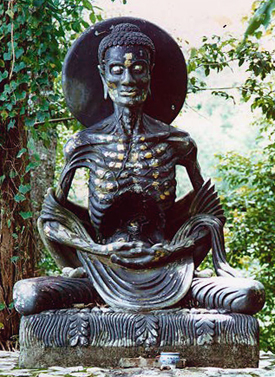
All he did is meditate, that is all: for twenty-four hours a day, for six years. This is extremely significant: in order to become a Buddha, you have to work. Thus his skeletal appearance symbolizes how much willpower it takes to reach the goal. You cannot become a Buddha just by believing in the teaching. You cannot become a Buddha by sitting around and enjoying a luxurious lifestyle. The Buddha was not watching television, he was not playing games, he was not enjoying any kind of luxurious lifestyle; he was sitting and meditating for six years, with extreme renunciation, not even caring for his body.
Yet, in spite of the need for willpower and renunciation, he was wasting away. He realized that in spite of his extreme ascetic practices, his mind was still craving. As much as he could - by force of willpower - deny his mind and its desires, it still craved. Thus, as much as he avoided desires, craving was still present. These two extremes - craving and aversion - became clear to him. It was also clear that mere willpower is not enough to overcome the mind. Renunciation alone is not enough. Meditation alone is not enough.
Arcanum 8 is the bringer of ordeals, trials, sufferings. It is under the influence of this Arcanum that Job is tested by Lucifer. Every initiate – by means of willpower – has to overcome all temptation, and remain true to the goal. This is symbolized by the woman in the Arcanum 8: she holds aloft the sword of willpower, and gazes up to the horns of the sacred bull: Ra, Apis. Yet: willpower alone is not enough. We also need the scale of equilibrium... and the woman.
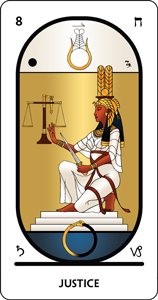
There are different stories that relate the moment in which Shakyamuni made a profound realization. The one that is probably most known is while seated in meditation, he was near a stream, a river, and coming down the stream was a small boat. On the boat was a musician playing an instrument called a vina, a stringed instrument like a guitar or a lute. This musician was plucking the strings, and when the Buddha Shakyamuni observed this musician, he comprehended that if the string is too loose, it will not make a note, and if the string is too tight, it will break, it has to be exactly the right level of tightness in order to have the right note and to play and sound beautiful. In that instant he realized that he was on the wrong path, that his austerities were too extreme. He needed to care for his physical body so that it could be a vehicle for his enlightenment, for his realization.
Now, this is a very critical moment. He realized that you have to take the middle way, not to be a victim of the extremes. This wisdom applies to almost everything in life. Shakyamuni lived his early life with extreme luxury, and when he renounced that, he went all the way to the other side of the swing of a pendulum, to extreme austerity. And what he recognized is that both extremes are harmful. In order to be balanced, you have to stand in the middle, to have equilibrium between these extremes.
This teaching of the "middle way" appears throughout his doctrine, and is significant on many levels. The TAO is the force of the balance, the scale, that equilibrates the extremes of craving and aversion.
In the moment of this realization, a woman appeared, coming to give him the milk of a thousand cows. Abandoning the lifestyle of the ascetic renunciate, he took the milk, drank it, restored his health, and glowed with health and beauty.
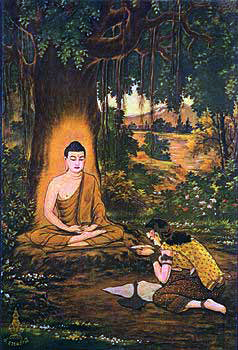
You may remember from other lectures that the cow is sacred, as a symbol of the Divine Mother. Who else is the woman but a symbol of Isis, the Divine Cow, spouse of Apis, the sacred bull of the Egyptians? (Note the horns of Apis at the top of Arcanum 8).

Who else is the sacred cow but the Divine Mother Prakriti / Hera / IO?
Who is the cow but the beloved of Krishna (Christ), the cowherd?
Who else is the Buddha, but Gautama, the cowherd?
Who else is the cow but the spouse of the bull Zeus / Indra / Apis / Osiris?
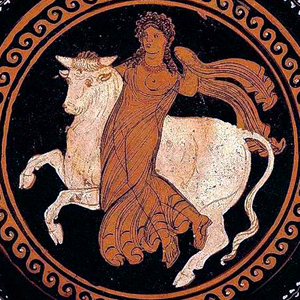
Thus Shayamuni, by means of the sword (willpower) and the scale (equilibrium), receives his gift: the sacred milk. The milk of the cow symbolizes Amrita, Soma, Ambrosia: the wine of the alchemist, the transmuted waters of life. Amrita / ambrosia is the sacred drink of the Gods: the source of their power.

You may recall the story of how the Gods and demons churn the great phallic rod in the ocean of existence by using a serpent, and as they churn that, the waters, the Soma, is churned up, the great ocean of life, the prakriti, and from that emerge many sacred elements. Of course, that story represents a process of alchemical transmutation that occurs within the psyche and physiology of an initiate who is working in chastity. One of the items that arises from that sacred water is a cow.
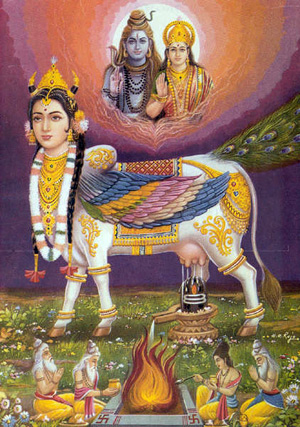
The name of that cow is Kamadhenu, which means "the wish fulfilling cow," - "kama" means love, but it can also mean desire, and can also relate to action. This wish-fulfilling cow gives forth the nectar of immortality, the Amrita. The milk is usually seen flowing onto the sacred Lingam Yoni of Shiva-Shakti: a symbol of the union of the masculine and feminine sexual organs.
So lo and behold in the life of Buddha: a woman appears, and gives him the nectar of immortality, and who else is that woman but his spouse? Comprehending the dangers of the two extremes, Shakyamuni returns once more to the loving arms of his spouse, and drinks of the sacred wine, and is thereby restored to health and equanimity.
Having comprehended the essential need to balance between the two extremes of indulgence and renunciation, he comprehends the need to properly manage of the sacred waters of sex.
Stated simply: those who indulge in sex destroy themselves. Likewise, those who renounce sex destroy themselves. What is necessary is the healthy use of sexuality: the sacred knowledge of sex that is hidden in chaste tantra.
Sex is part of being human: but sex when misused (craved through fornication) or ignored (avoided through "celibacy") is destructive. It is this secret that is hidden in the story of the Buddha.
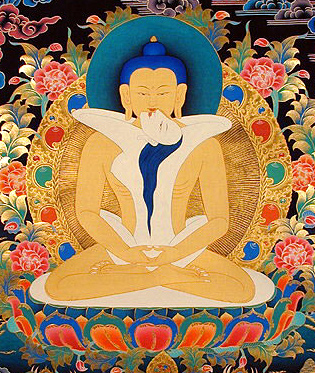
At this moment, having equilibrated himself on the path, the other ascetics condemn him, saying he abandoned the path. This is how it is for the initiates of the path to absolute liberation: the walkers of the left and right do not understand the walkers of the Middle Way.
Demons and Saints look with horror and terror at the revolutionary Adepts of the Path of the Middle.
No one understands these rebels of the Path of the Middle.
The path is sexual. We advance by annihilating the ego and sacrificing ourselves for humanity.
The Pratyeka Buddhas (even after having built the existential superior bodies of the Being) are not Bodhisattvas. Obviously, the Pratyeka Buddhas fell in the path of the Right.
There are also a great deal of Masters who fell on the path of the Left by means of Black Tantrism. - The Pistis Sophia Unveiled
